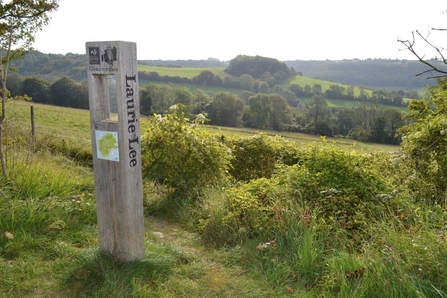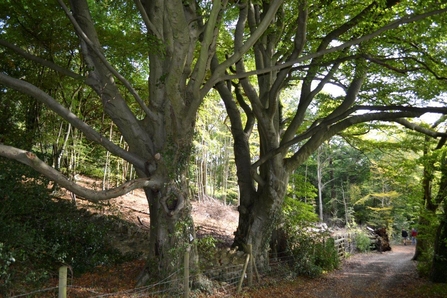
Laurie Lee Woods - Start of walk
Along the ridge

Laurie Lee Woods - Start of walk
How long is the walk? Five miles in total
How much time does it take? The whole walk takes between three to five hours – we missed a turning and walked 4.1 miles, which lasted two hours and 40 minutes
Difficulty rating: mostly moderate but one particularly demanding steep slope
Terrain: uneven paths, some slopes, including one that requires a bit of effort, mud during wet times of year, grass. Not suitable for wheelchairs
What to spot: Beech leaves changing colour, limestone grassland wild flowers such as harebells and scabious, rare breed cattle, the tiny rare snail Lauria sempronii, 14 speices of orchid in summer and lady’s tresses in autumn on Swifts Hill, amazing views and inspiring snatches of Laurie Lee’s poetry.
Perfect for: families with energetic children, friends having a catch up, walking groups: travel on to The Woolpack in Slad for a well-earned glass of ale.

Poem with a view
Poetry Posts
The Laurie Lee Way was created by Gloucestershire Wildlife Trust in 2013 to showcase not only the author’s beloved Slad Valley, but several special places, now nature reserves, he would have known throughout his life. At the same time the countryside’s connection with the author is celebrated by ten strategically-placed wooden ‘poetry posts’ that offer the walker the opportunity to pause, read and reflect.
The entire Bradley family – the ages of whom span four decades – decided to make the most of a gloriously sunny September morning to embark on the Laurie Lee Wildlife Trail.
Armed with a leaflet produced by the Gloucestershire Wildlife Trust, available here, our route began at a layby on the B4070, opposite the sign pointing to the tiny hamlet of Bulls Cross, and took us a few metres up the road until we joined a footpath, pausing briefly to enjoy the view of Painswick.
Before we knew it we had left the 21st Century behind and were strolling towards Longridge Wood and admiring pollarded beech trees, along with coppiced hazel and ash, as we travelled at a gentle pace along a track, keeping our eyes peeled for circular signs bearing red arrows that confirmed we were keeping to the route.

Follow the red arrows
Steep climb
The sight of a lake up ahead was the indication we needed to turn onto a footpath that descended down towards Slad Brook before ascending steeply for 100 metres. This climb was the most physically demanding part of the walk and required a couple of stops so that we could catch our breath, but in the great scheme of things it was well worth the physical exertion in order to enjoy the glories that lay ahead.
Eventually we reached Slad Slope, a small pocket of unimproved limestone grassland in which harebell, thyme and yarrow were still blooming, and stood for a while to take in the wonderful views towards the Slad Valley and Catswood, and the Snows Farm nature reserve to which we would soon be heading. Close to the entrance path were the remains of an old shop, now just a few stones, but it drove home how different life was in this remote spot years ago. A poetry post bearing an excerpt from Lee’s poem ‘Home From Abroad’, which talked of breathing ‘the hay blown airs of home’, lingered in my mind as we picked our way through scrub and wooded areas, taking care to avoid rabbit holes, and headed on towards Catswood, an ancient woodland of ash, beech and hazel, from which we were able to enjoy more views across the valley

Beech Woodland
Missed opportunity
It was just beyond this point, dear reader, that we somehow became fixated with the sign to Furner’s Farm and walked straight ahead, therefore missing the instruction to turn left into Laurie Lee Wood nature reserve, which dates back to beyond 1600 and has a stone wall containing the rare and tiny snail Lauria sempronii, and on to Swift’s Hill which, having visited it in the past, I know to be well worth the journey to see.
Instead, and somewhat fortuitiously, we joined the Laurie Lee Way a little further along at Furners Farm and headed towards Steanbridge (Stonebridge) Lane, passing Bridge Pond and a sketchy recollection of the passage in Cider with Rosie in which Fred the Milkman finds the body of the unfortunate Miss Flynn in the water.
A little further along, past the war memorial, is the drive to the Frith Wood nature reserve. Here the Laurie Lee Wildlife Way suggests taking a detour to the left to enjoy lunch at The Woolpack at Slad, a pub that’s remained pretty much unaltered over the years and, at this time of high alert over Coronavirus, offers plenty of outdoor seating for those looking to stop and rest a while.
Woolpack Stop Off
My motley crew decided, however, to turn right to follow the path into Frith Wood and on to the B4070, where we picked up our car and drove into Slad for a refreshing drink at the village hostelry.
The Laurie Lee Wildlife Way is worth following at any time of the year, although it would appear that some of the footpaths can get rather muddy when the weather is especially wet – after all, the name Slad comes from the Saxon ‘Slaed’, which meant ‘damp valley’.
I hope to return in spring, when the woodlands are filled with carpets of bluebells, and later on in autumn, as the beech leaves put on their autumn displays.
Generally the route outlined by Gloucestershire Wildlife Trust is easy to follow, especially with the reassurance of the small red arrows dotted around much of the trail, and its leaflet, illustrated by local artist Andy Lovell, includes plenty of interesting information about features to look out for.

Through the Beech Woodland
Ash Die Back
Some sections of the current route differ slightly from the one shown on the leaflet, however, with the deadly ash die back disease causing the need for a diversion early on in the walk for safety reasons. Keen eyed walkers will also notice that the odd beech tree has toppled over, a combination of old age and the impact of high winds, leading them to the exposure of their giant root balls, which in themselves provide an ideal habitat for invertebrates. Meanwhile those a little nervous of cows should be aware that livestock are used to maintain the grassy slopes along certain points of the route.
All in all the Laurie Lee Wildlife Way is a jewel of a walking trail that offers much to Cotswolds residents and visitors alike. It’s the perfect way to step off the treadmill of the 21st Century into a world made familiar by the writings of a local man who now lies in a spot between Slad’s small church and The Woolpack or, as he put it, between ‘the temporal and the spiritual’.